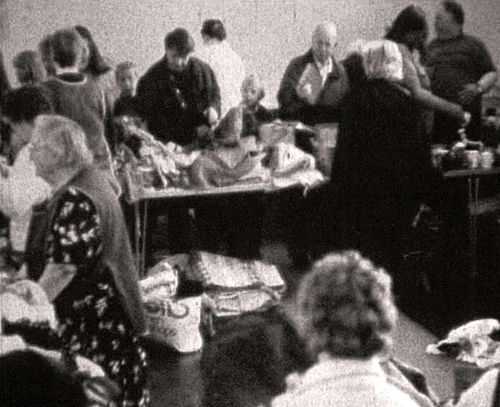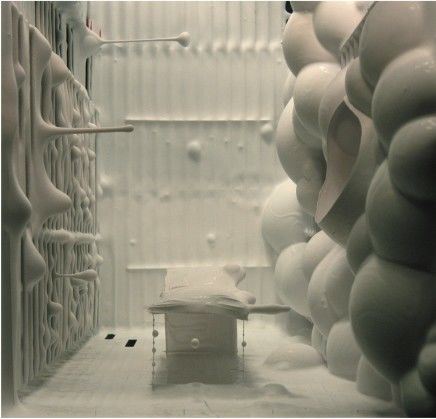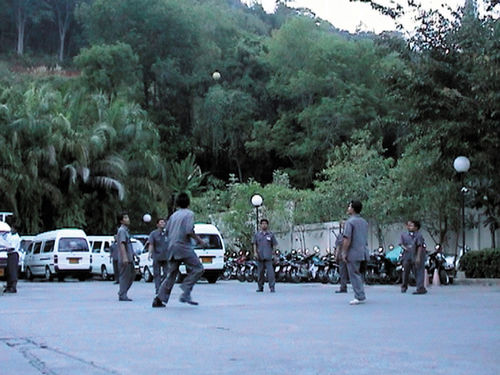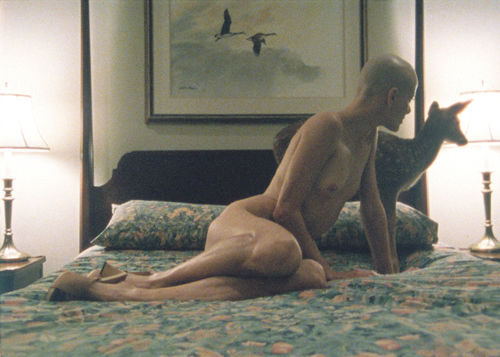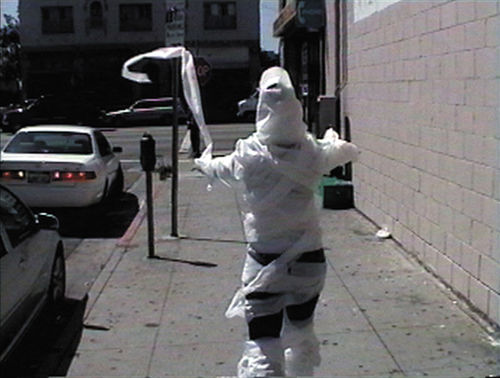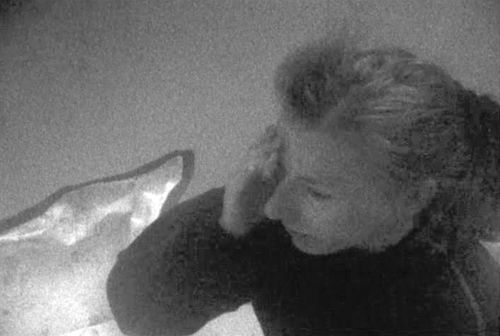
Hammer Projects: Displaced
- – This is a past exhibition
This exhibition brings together six short videos by an international group of emerging artists. The consecutively screened, 34-minute program includes videos by Mircea Cantor (Romania), Jennifer Lane (Los Angeles), Rosalind Nashashibi (Glasgow, Scotland), Terry Phillips (Los Angeles), Reynold Reynolds & Patrick Jolley (New York City), and Saskia Olde Wolbers (The Netherlands). The works explore the theme of displacement by eliminating various types of boundaries in order to open up fresh possibilities for perceiving and understanding the world around them.
This exhibition was organized by Claudine Isé, assistant curator.
Biographies
Mircea Cantor was born in Transylvania, Romania, in 1977 and currently lives and works in Nantes, France. He participated in the 2001 and 2003 Venice Biennales and will be included in the 2003 Tirana Biennale, Tirana, Albania. He has had solo exhibitions at Trans Area, New York (2003), and Galerie Yvon Lambert, Paris (2002), and has participated in group exhibitions at Kunstverein Munich (2003); Forwart 2002, Brussels (2002); and Musée d’Art Moderne de la Ville de Paris (2001), among others.
Jennifer Lane was born in Dallas, Texas, in 1968. She received a B.F.A. from the Rhode Island School of Design, Providence, in 1991 and pursued graduate studies at Art Center College of Design in Pasadena, California. Recently her drawings and films have been featured in screenings and exhibitions at China Art Objects, Los Angeles (2003); Hayworth Gallery, Los Angeles; New Image Art, Los Angeles; Jessica Murray Projects, Brooklyn; Royal College of Art, London (2002); and Laemmle’s Colorado Theater, Pasadena (2000).
Rosalind Nashashibi was born in Croydon, England, in 1973. She earned an M.F.A. from the Glasgow School of Art in 2000. Nashashibi was awarded the Beck’s Futures Art Prize in 2003 and is included in the 2003 Venice Biennale. She has also been awarded a Scottish Arts Council Research and Development Grant and the AM Qattan Foundation Artist’s Award. Her work has recently been exhibited at the ICA, London; Fruitmarket Gallery, Edinburgh; CCA, Glasgow; and Foksal Gallery Foundation, Warsaw (2003), among others.
Saskia Olde Wolbers was born in Breda, The Netherlands, in 1971 and currently lives and works in London. She received this year’s Baloise Art Prize at Art Basel (2003). She has had solo exhibitions at the Stedelijk Museum Bureau, Amsterdam (2000), and the Chisenhale Gallery, London (1999), and has recently participated in group shows at the Tate Britain, London; Museum Boijmans van Beuningen, Rotterdam; Kunsthalle, Saint Gall, Switzerland (2003); and Reality Check, a touring British Council exhibition (2002–3).
Terri Phillips received an M.F.A. from the California Institute of the Arts in 1996. She has had solo exhibitions at the Acuna-Hansen Gallery, Los Angeles (2003 and 2002), and has recently participated in group exhibitions at the Bart Wells Institute, London (2002); Cohan Leslie and Browne, New York; PS1, Long Island City, New York; Black Dragon Society, Los Angeles (2001); and Galerie Yvon Lambert, Paris (2000).
Patrick Jolley received an M.F.A. from the School of Visual Arts, New York, in 1995 and a B.A. in fine art from the National College of Art and Design, Dublin, Ireland, in 1989. Recently he has had solo exhibitions at the Antonella Nicola Gallery, Turin, Italy (2002), and Roebling Hall, New York (1999). He has participated in group exhibitions at Tramway, Glasgow; Festival Internacional de Curtas Metrogens, Vila do Conde, Portugal (2002); Secession, Vienna (2001); and the Havana Biennial, Cuba (2000), among others.
Reynold Reynolds received an M.F.A. from the School of Visual Arts, New York, in 1995 and a B.A. in physics from the University of Colorado, Boulder. Most recently he has exhibited his work at the Wood Street Gallery, Pittsburgh (2003); Roebling Hall, Brooklyn; BIG Torino Biennale, Turin, Italy (2002); ArtHouse, Dublin, Ireland; Impakt Festival, Utrecht, the Netherlands (2001); Tate Modern, London; Studio Gallery, Berlin; Kunsthaus, Zurich (2000); Project Arts Centre, Dublin, Ireland; and The Old Schoolhouse, Hoxton Square, London (1999).
Checklist of the Exhibition
Mircea Cantor
Dead Time, 2003
Single-channel video, color, transferred to DVD
2:23 minutes
Courtesy the artist and Galerie Yvon Lambert, Paris
Jennifer Lane
Fawn, 2003
16mm film, color, DVD transfer
4:17 minutes
Courtesy the artist and China Art Objects, Los Angeles
Rosalind Nashashibi
The States of Things, 2000
Black-and-white 16mm reversal film,
transferred to BetaSP and DVD
3:30 minutes
Courtesy the artist
Saskia Olde Wolbers
Placebo, 2002
Single-channel video, color, transferred to DVD
6:13 minutes
Courtesy the artist and Galerie Diana Stigter, Amsterdam
Terri Phillips
Mummy, 2003
Single-channel video, color, transferred to DVD
7:52 minutes
Courtesy the artist and Acuna-Hansen Gallery, Los Angeles
Reynold Reynolds and Patrick Jolley
The Drowning Room (An Underwater Soap Opera), 1999
Super 8 film, black-and-white, transferred to video and DVD
10 minutes
Courtesy the artists and Roebling Hall, Brooklyn
Essay
By Claudine Isé
This exhibition explores displaced contexts and the structures of interpretation we bring to them. Each of the six single-channel video projections evokes a sense of physical, psychological, cultural, or geopolitical dislocation. An otherwise unremarkable family attempts to go about its daily business in a house that is completely submerged in water. A female narrator—her disembodied voice floating over a series of abstract, liquid forms—tells a story of betrayal while lying paralyzed in a hospital bed. A group of unidentified shoppers sift through piles of clothing, an off-screen Egyptian melody providing the only cue as to where and when the scene is taking place. These scenarios are all structured by some form of displacement—between nature and culture, self and other, past and present, or East and West.
Displacement has been a dominant cultural theme since the early nineteenth century, expressive not only of the personal and political alienation that characterized modernism and modern culture but also of a number of key intellectual breakthroughs that defined the modern era, such as Marx’s theories of commodity fetishism and Freudian psychoanalysis. This sense of dislocation only intensified with postmodernism's emphasis on difference and fragmented subjectivity. Today the global tourist industry and an increasingly globalized mass media have made the entire world seem more accessible than ever before; yet when so much of our perception of “the Other” is mediated by images rather than context, how can we ever be certain that our assumptions are grounded in reality? The artists in this exhibition employ various strategies of displacement to defamiliarize audiences, thereby enabling us to view commonplace scenarios from decidedly unfamiliar standpoints.
In classic film melodrama, the characters’ powerful, deep-seated, and usually unacknowledged emotions are often displaced onto aspects of the mise-en-scène, not unlike the condensation and displacement of meaning that occur with dream symbols and figures of speech. In Reynold Reynolds and Patrick Jolley’s black-and-white film The Drowning Room (An Underwater Soap Opera) (1999), a seemingly ordinary family is seen going about its daily business in a house that is completely filled with water. The family members, either refusing to notice this fact or simply taking it in stride, continue their activities as best they can: shoveling their fish dinner into their mouths as tiny food particles waft around their faces like plankton, reading waterlogged newspapers, and petting their suspiciously stiff-limbed cat as if all this were perfectly normal. They seem to exist in a state of suspended animation, perhaps thinking that if they pretend the water isn’t there, it won’t drown them. When viewed in the context of recent global events, the family’s domestic isolation can be seen as a metaphor for political isolationism and a willful disconnection from the events of the world outside.
The tale recounted in Saskia Olde Wolbers’s Placebo (2002) also exhibits similarities to domestic melodrama, particularly soap operas. Inspired by stories the artist learns about from tabloid newspapers and television (in this case, that of Jean-Claude Romand, a compulsive liar who for eighteen years pretended to be a doctor for the World Health Organization), Olde Wolbers’s films often revolve around characters who exist somewhere between dreams and reality. The images in her films conjure womblike landscapes that remind us of the primary role that language plays in the construction of subjectivity. Her use of off-camera narration coupled with abstract, biomorphic imagery creates a decentering experience for viewers. As the piece opens, we hear an off-screen female voice: “Here I am . . . lying next to my lover, Jean, in intensive care.” The unnamed woman reveals that she and her paramour were both left paralyzed after their car crashed head-on into a tree. They were rushed to the same hospital where he worked as a surgeon and she as a nurse. As the woman tells her story, the screen oozes with an amorphous white fluid dripping horizontally across the screen (actually, paint made to flow through small wire constructions), an evocation of the woman’s mental state as she slips in and out of consciousness as well as of the “white shiny veins” of the hospital’s halls and corridors. The woman has gradually realized that her lover was not a doctor, nor was he married. He had invented an identity in order to hide the emptiness of his life. Just as a placebo (from the Latin for “I shall please”) stands in for an authentic remedy, Jean’s fantasies took the place of authentic lived experience, much to the dismay of the woman who finds herself unwittingly entangled in them.
Jennifer Lane’s film Fawn (2003) continually shifts the point of view between its human and animal protagonists, refusing to privilege one over the other. The film opens on a bald, white-robed, androgynous woman cutting vegetables in a kitchen alongside a young deer. These two characters engage in a subtle pas de deux as they grow increasingly intimate. The interior’s rigidly balanced decor and multiple reflective surfaces make for a cold and inhospitable environment. Both the woman and the deer seem like alien creatures struggling to find a place for themselves within this meticulously designed yet unnatural setting. In one scene the woman, now completely nude, stares at herself in a dressing room mirror as if she has no idea who she is or how she got there. She strokes the deer tentatively, her smooth flesh juxtaposed with the fawn’s soft fur. The figure of the woman trapped within the home is a plot device common to the domestic melodrama and the horror film (George Cukor’s Gaslight and Roman Polanski’s Repulsion, for example). In Lane’s film, this sense of entrapment is complicated by the presence of the young deer, whose actions mirror those of the woman. Indeed, throughout Fawn the natural world is displaced onto pictures and decorative objects scattered throughout the home. Botanical prints and drawings of birds, crabs, and other animals line the walls, and a pair of seashells rest on the edge of the bathtub. In one scene the woman’s oddly shaped shoes are juxtaposed with the deer’s cloven hooves. Bird sounds can be heard on the film’s audio track, which further displaces the natural onto the domestic. In the film’s final sequence the woman appears outside the house, her expression unreadable as she walks through a field with mountains rising in the background. We then cut to an interior shot of the fawn standing awkwardly upon the bed. Whereas the woman seems to have escaped the confines of the house, the deer remains inside, struggling to maintain his balance.
Terri Phillips’s videotaped performance Mummy (2003) draws our attention to the absurdities of trying to replay childhood experience as an adult. When Phillips was young, she and her brother would wrap white toilet paper around their bodies and pretend that they were mummies. But when Phillips reenacts the game alone, as an adult artist, in full public view, the experience could not be more different. The video shows Phillips covered in toilet tissue, winding her way through an institutional-like series of hallways and stairwells and out onto a busy avenue, her arms stretched forward like the mummies in old Boris Karloff films or Scooby-Doo cartoons. As she wanders down the street, she is virtually ignored by passers-by, who look the other way as she staggers past. Phillips’s make-believe alter ego appears increasingly pathetic as the tissue begins to unravel and trail between her legs like ragged clothing. Viewers may feel uneasy, not knowing whether to laugh at or feel sorry for this “undead” oddball, who brings to mind not only the displaced condition of homeless street-dwellers but also a number of tragically misunderstood literary “monsters,” such as Frankenstein’s creature, Quasimodo, and Boo Radley. By displacing a memory from the past onto the actions of the present, Phillips foregrounds the extreme difficulty, if not impossibility, of retaining the purity of childhood fantasy. In exchange Phillips provides us with a distinctly adult take on what it means to live as an outcast, in a state of exile from oneself, from one’s memories, and from the compassion of others.
The Romanian artist Mircea Cantor lives a life of voluntary and perpetual displacement. Born in 1977, Cantor left home soon after the Romanian borders opened in the early 1990s and began hitchhiking across Europe in order to see and understand how other people live. Yet he is acutely aware that the touristic gaze can be deceiving: prone to cultural bias, misinterpretation, and misread signals. Several of his recent works examine the luxury hotel industry, which touts the beauty and distinction of native regions yet steers travelers toward resorts that all look reassuringly similar (at least to Western eyes). Cantor’s video Dead Time (2003) takes place in a parking lot adjacent to one such resort. Seen in slow motion, a group of uniformed men are trying to keep a soccer ball up in the air for as long as they can. We cannot tell if the men are workers or prisoners, nor can we identify where exactly the game is taking place. The sound track—consisting of a slow, rhythmic series of gonglike tones—heightens the sense of entrapment. The men are in fact taxi drivers who work for a hotel in Thailand, playing soccer during the “dead time” between fares. The taxi driver’s job is to ferry tourists from one part of town to the other. Yet the drivers are themselves condemned to a kind of endless displacement as they drive from place to place without a final resting point. Their attempts to keep the ball in play mirror their ceaseless travel in support of the global tourist industry, of which they themselves can rarely, if ever, partake.
Like Cantor, Rosalind Nashashibi is interested in displaced contexts and the interpretive strategies we bring to them. Working primarily with 16mm film and a small Bolex camera, she films everyday people going about their business in streets, cafés, barbershops, and parks. Offering no commentary on the scenes she observes, Nashashibi selects moments when people are involved in breaks or other leisure activities. In a work from 2000 entitled The States of Things, she filmed a group of women sorting through piles of secondhand clothing at a Salvation Army sale. Her use of idiomatic documentary techniques—such as a hand-held, roving camera; extended long shots; and grainy black-and-white film stock—draws a discursive veil between the viewer and the scene. The film’s visual and audio tracks are at cross-purposes. The musical score—which consists of the powerful, lilting vocals of the Egyptian diva Um Kulthoum (1904–1975)—functions as a kind of displaced signifier that leads viewers to assume that the actions are taking place somewhere in the Middle East. Nashashibi’s use of grainy film stock may also suggest that the film was shot decades ago, but a closer look at the women’s style of dress makes it clear not only that the footage is contemporary but also that the action is occurring in the West (it was in fact filmed in Glasgow, Scotland). The confusion between East and West, and our heightened anxieties about these polarizing distinctions, is at the heart of Nashashibi’s project. As modernism segued to postmodernism and industrial capitalism morphs into globalism, displacement continues to provide us with a running theme, a means of drawing connections between the disparate and profound changes that are rapidly reshaping not just the world but the ways in which we perceive and understand it.
Claudine Isé is an assistant curator at the UCLA Hammer Museum.
Hammer Projects are made possible with support from The Horace W. Goldsmith Foundation, The Annenberg Foundation, the Los Angeles County Arts Commission and members of the Hammer Circle.



